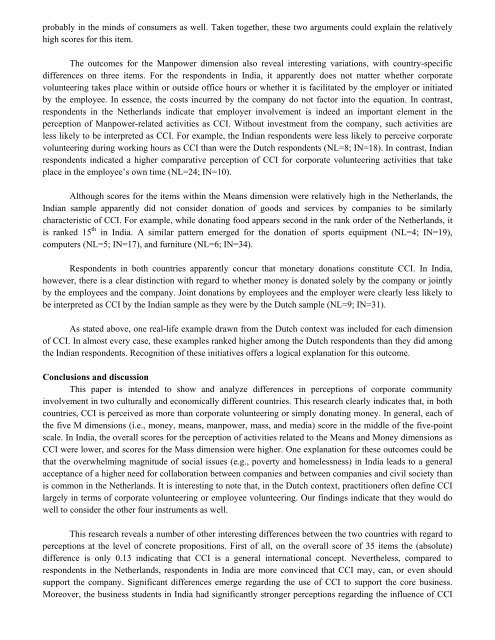hoofdstuk%20boek%20nitte%20def
hoofdstuk%20boek%20nitte%20def
hoofdstuk%20boek%20nitte%20def
Create successful ePaper yourself
Turn your PDF publications into a flip-book with our unique Google optimized e-Paper software.
probably in the minds of consumers as well. Taken together, these two arguments could explain the relatively<br />
high scores for this item.<br />
The outcomes for the Manpower dimension also reveal interesting variations, with country-specific<br />
differences on three items. For the respondents in India, it apparently does not matter whether corporate<br />
volunteering takes place within or outside office hours or whether it is facilitated by the employer or initiated<br />
by the employee. In essence, the costs incurred by the company do not factor into the equation. In contrast,<br />
respondents in the Netherlands indicate that employer involvement is indeed an important element in the<br />
perception of Manpower-related activities as CCI. Without investment from the company, such activities are<br />
less likely to be interpreted as CCI. For example, the Indian respondents were less likely to perceive corporate<br />
volunteering during working hours as CCI than were the Dutch respondents (NL=8; IN=18). In contrast, Indian<br />
respondents indicated a higher comparative perception of CCI for corporate volunteering activities that take<br />
place in the employee’s own time (NL=24; IN=10).<br />
Although scores for the items within the Means dimension were relatively high in the Netherlands, the<br />
Indian sample apparently did not consider donation of goods and services by companies to be similarly<br />
characteristic of CCI. For example, while donating food appears second in the rank order of the Netherlands, it<br />
is ranked 15 th in India. A similar pattern emerged for the donation of sports equipment (NL=4; IN=19),<br />
computers (NL=5; IN=17), and furniture (NL=6; IN=34).<br />
Respondents in both countries apparently concur that monetary donations constitute CCI. In India,<br />
however, there is a clear distinction with regard to whether money is donated solely by the company or jointly<br />
by the employees and the company. Joint donations by employees and the employer were clearly less likely to<br />
be interpreted as CCI by the Indian sample as they were by the Dutch sample (NL=9; IN=31).<br />
As stated above, one real-life example drawn from the Dutch context was included for each dimension<br />
of CCI. In almost every case, these examples ranked higher among the Dutch respondents than they did among<br />
the Indian respondents. Recognition of these initiatives offers a logical explanation for this outcome.<br />
Conclusions and discussion<br />
This paper is intended to show and analyze differences in perceptions of corporate community<br />
involvement in two culturally and economically different countries. This research clearly indicates that, in both<br />
countries, CCI is perceived as more than corporate volunteering or simply donating money. In general, each of<br />
the five M dimensions (i.e., money, means, manpower, mass, and media) score in the middle of the five-point<br />
scale. In India, the overall scores for the perception of activities related to the Means and Money dimensions as<br />
CCI were lower, and scores for the Mass dimension were higher. One explanation for these outcomes could be<br />
that the overwhelming magnitude of social issues (e.g., poverty and homelessness) in India leads to a general<br />
acceptance of a higher need for collaboration between companies and between companies and civil society than<br />
is common in the Netherlands. It is interesting to note that, in the Dutch context, practitioners often define CCI<br />
largely in terms of corporate volunteering or employee volunteering. Our findings indicate that they would do<br />
well to consider the other four instruments as well.<br />
This research reveals a number of other interesting differences between the two countries with regard to<br />
perceptions at the level of concrete propositions. First of all, on the overall score of 35 items the (absolute)<br />
difference is only 0.13 indicating that CCI is a general international concept. Nevertheless, compared to<br />
respondents in the Netherlands, respondents in India are more convinced that CCI may, can, or even should<br />
support the company. Significant differences emerge regarding the use of CCI to support the core business.<br />
Moreover, the business students in India had significantly stronger perceptions regarding the influence of CCI



